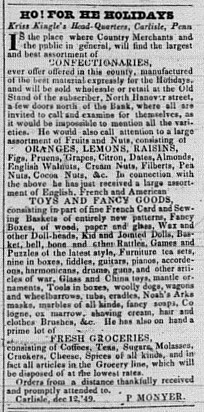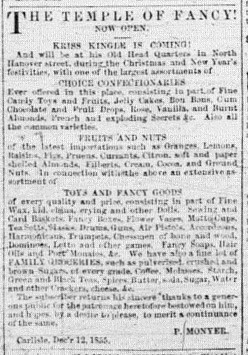“Kriss Kringle’s Head Quarters” and “The Temple of Fancy,” declared Monyer’s newspaper advertisements.1 Monyer’s store was an emporium of delights for children. Its glass cases displayed candy toys, bon-bons, chocolates, fruit drops, and colorful hard candies. Its shelves were lined with dolls and games, puzzles and drums and toys of all kinds. “Reminiscing about bygone days in Carlisle an old timer wrote:
Mr. Peter Monyer, confectioner, exercised his art in candy toys, candy dolls, baskets, canes, etc., in addition to his stock of toys in wood and metal. The lucrative business…necessitated the employment of a large number of the town’s most popular young men. And such good natured jostling crowds on Christmas eve and Christmas day.”2
Monyer came to Carlisle about 1840 where he met his future wife, Elizabeth Ann Ecker. They were married on June 16, 1842,3 and a family followed quickly. The 1850 U. S. Census shows that Monyer’s household consisted of Peter and his wife, three children, his brother-in-law and two young men who were all working as confectioners for Monyer, and a single woman who may have been a domestic.
By 1860, Monyer’s household consisted of 13 people including Peter and his wife, seven children, a brother, his mother-in-law, his brother-in-law and one domestic.4 Such a large household likely contributed to Monyer’s debts. He owed Dr. W. W. Dale $460, and when he couldn’t pay him, he was sued at the August 1860 Term of Court. Much of his property was levied to pay the debt including two marble slabs and stands, two sets of moulds, five pans, four dippers, a sour drop and press machine, glass jars, scales, weights and measures, six show cases, two bulk windows, a copper kettle, confectioners tools, etc.5
Peter served during the Civil War as a private in Co. A 101st Regiment from August 31, 1864 until June 25, 1865. His son, William A., also served. Fortunately, both survived. Peter continued to make candy after he returned. By 1870, three of Monyer’s sons, William, John and Thomas were also confectioners.6
Competition for business increased, and by 1877 there were at least six other confectionary establishments in Carlisle.7 By then, Monyer’s son, William A., was the manager of S. A. Haverstick’s Toy and Candy Store on West High Street, while Monyer was still making candy at his shop on East High Street.
Peter Monyer died on February 17, 1882. The minister of St. John’s Episcopal Church held a service at Monyer’s home, and then at his gravesite. His obituary stated that he was: “A well known and respected citizen of Carlisle…Mr. M. was a member of several secret societies,8 and stood well in all of them. He was a member of Company A, 101st Regiment P. V. during the war and proved himself a good soldier. His remains were buried Sunday afternoon in the Old Graveyard.”9
Monyer’s wife, Elizabeth, died at their home at the corner of East High and East streets on December 19, 1887 after a long illness. Her obituary stated that her maiden name was Eckert and that her parents were natives of Switzerland.10 Monyer’s son Thomas remained in Carlisle after his father’s death and had his candy shop at 99 East High Street. William moved to Reading, Pennsylvania where he was a confectioner also.


